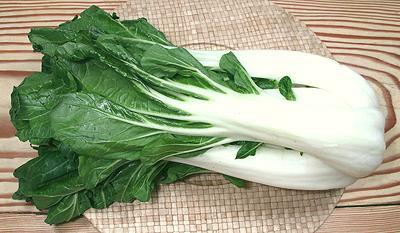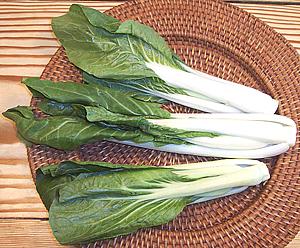Bok Choy is not a cabbage but turnip greens. All versions feature a sharper flavor with thicker, crisper stems than Napa Cabbage (also a turnip green). The white stemmed varieties are very popular in stir fries and soups, the green stemmed Shanghai Bok Choy is often steamed. Bok choy does not form tight heads but the clusters of stems form a tight bundle
 This large form is now widely available in North American produce markets
and even many supermarkets. This vegetable is the "cabbage" of
southern China, while Napa Cabbage (also a
turnip green) takes its place in the north. It is available in a variety
of sizes, but the photo specimen was 14-1/2 inches long and weighed just
over 3 pounds.
This large form is now widely available in North American produce markets
and even many supermarkets. This vegetable is the "cabbage" of
southern China, while Napa Cabbage (also a
turnip green) takes its place in the north. It is available in a variety
of sizes, but the photo specimen was 14-1/2 inches long and weighed just
over 3 pounds.
More on Asian Greens .
 This is the "real" baby bok choy, one of my favorite vegetables for
stir fries and such, but it's not widely available outside markets
serving Asian communities. It is not really "baby", it's a tiny variety,
as witnessed by the mature flower heads you will find on it. There are
actually a number of miniature cultivars, some smaller, some larger.
Taste is similar to full size bok choy but the distribution of stem
and leaf is more pleasing in my opinion - more leaf.
This is the "real" baby bok choy, one of my favorite vegetables for
stir fries and such, but it's not widely available outside markets
serving Asian communities. It is not really "baby", it's a tiny variety,
as witnessed by the mature flower heads you will find on it. There are
actually a number of miniature cultivars, some smaller, some larger.
Taste is similar to full size bok choy but the distribution of stem
and leaf is more pleasing in my opinion - more leaf.
Prep: The main problem with this form is getting all
the grit washed out. I usually strip the biggest stems off, then split
the remaining head in half lengthwise which makes it easier to fluff the
leaves and wash it.
 This cultivar is longer and narrower than a regular mid-size bok
choy, but it tastes the same and can be used in exactly the same way.
It does have the advantage that the stems are less bulky, thus need
less lead time over the leaves when cooking and the texture of the
dish will be less coarse. It frequently shows up in Asian markets in
Los Angeles, but probably not much elsewhere yet.
This cultivar is longer and narrower than a regular mid-size bok
choy, but it tastes the same and can be used in exactly the same way.
It does have the advantage that the stems are less bulky, thus need
less lead time over the leaves when cooking and the texture of the
dish will be less coarse. It frequently shows up in Asian markets in
Los Angeles, but probably not much elsewhere yet.
When cooking, give the stems a lead of 1 to 4 minutes depending on size and method. For stir fries, the leaves should be stirred in just enough to be coated with oil, then the liquid ingredients are added. Cover and simmer until the stem slices are crisp tender. Do not overcook.